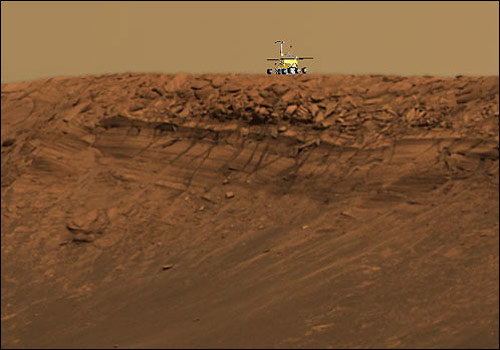Avi Blizovsky

In the photo, a simulation of the challenge facing the vehicle: Endurance Crater, which is 130 meters wide
Direct link to this page: https://www.hayadan.org.il/mars080504.html
Just before closing the news to the site, NASA announced that it would send Opportunity to the crater's coffee mission to find areas where it would be possible to descend and, above all, safely ascend back. father.
NASA scientists are considering whether to send the Mars rover Optroenity to the impact crater that the vehicle has been making its way to for the past three weeks. Opportunity is now above the rim of the 130 meter wide crater, on a meridian plane near the equator.
Prof. Steve Squires, the scientific director of the Mars Rover Project, says that the crater contains rocks of great scientific interest. However, the problem facing NASA is that the vehicle may encounter difficulties exiting the crater after entering it. "By looking deeper, we can look back in time. This is an amazing crater, many meters of history from Adamim. We are expecting an amazing performance" said Prof. Squires.
In particular, the scientists are interested in many layers of exposed bedrock arranged in rows across most of the crater. "There is a rock unit below the one we explored in Eagle Crater," said Prof. Squires. "She looks completely different from anything we've seen so far. It is big, massive and has a story to tell us."
According to him, if we decide to slide the vehicle into the valley, it may provide much more scientific output than on the plateau it has explored so far.
The depth of Endurance Crater is over 20 meters, from the highest point of its rim. This means a crater 10 times larger than Eagle Crater, where the vehicle found evidence of the existence of a large body of liquid water in the meridian plane sometime in the past.
By looking deeper into the bedrock of Mars, scientists may know much more about the history of water on the Martian surface. The vehicle is now parked on the west bank of the crater. NASA scientists are now identifying interesting science targets and assessing how difficult it would be for the vehicle to descend into the crater and come back up.
Prof. Squires says that it is possible that the vehicle could be sent in even if it would be dangerous to bring it back. "I can imagine materials for which it is worth taking a risk." said. However, before he can take such a step, there is still much scientific work to be done on the levels. There are configurations that have been nicknamed the heatshield, the fragments, the ripples. It might be worth considering traveling south and only then going down to the crater. I don't know", concluded Sciors.
For news at the BBC
Yadan Mars - current missions
https://www.hayadan.org.il/BuildaGate4/general2/data_card.php?Cat=~~~835755408~~~16&SiteName=hayadan
